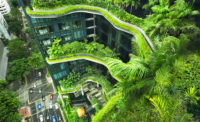SkyVille@Dawson
Gardens in the Sky
















Architects & Firms
Singapore
Right next to SCDA's SkyTerrace, WOHA's SkyVille@Dawson offers a different response to the Singapore Housing & Development Board's call for new approaches to public housing. While SCDA tackled the problem of multigenerational living, WOHA looked at ways of providing a sense of community in a huge complex with 960 dwelling units. Both projects, which will open in 2015, emphasize sustainable design adapted to a tropical climate and connect their buildings to a number of new and existing outdoor spaces and parks.
Roughly 80 percent of Singaporeans live in public housing and most buy their units, so projects are populated by the middle as well as the working class. With the quality of the buildings high and the price of the apartments low (from one-quarter to one-half that of market-rate units), only the wealthy live in privately developed housing. And since the government deducts money from all residents' paychecks and puts it in housing savings accounts, almost everyone can afford to buy an apartment just a few years after starting a career.
Wong Mun Summ and Richard Hassell, WOHA's two principals, realized from the start that they needed to break the enormous scale of their project into humane pieces. So they developed the concept of “sky villages”: 11-story neighborhoods oriented around communal gardens with residences on four angled sides. Each sky village has 80 apartments looking onto and sharing use of its high-rise garden, a scheme that encourages interaction among neighbors. Instead of enclosed hallways, covered balconies overlooking the garden provide access to all dwelling units and serve as shaded places for people to meet. WOHA stacked four villages on top of one another in each of the complex's three diamond-shaped towers. Roof gardens at the top of each building and covered spaces at the base offer a variety of outdoor places where residents can socialize and enjoy Singapore's lush setting.
The architects designed the project so all apartments face either north or south and oriented the buildings to maximize their relationship to an existing park on one side and a new landscaped area on the other. The project's sky gardens and covered balconies bring cooling breezes and daylight into the residences so they can be naturally ventilated instead of air-conditioned. Horizontal and vertical shades on the outside of the buildings reduce solar loads inside, while photovoltaic arrays on the roofs provide electricity for all common spaces. A 495-foot-long bioswale running on one side of the site filters water naturally before discharging it.
The project's entirely precast-concrete structure allows apartments to be free of columns. As a result, interior walls can be removed or moved, creating flexible layouts. To improve comfort in the cross-ventilated units, WOHA designed a new type of monsoon window, set a few feet above the floor so it directs breezes to people as they're seated. While privately developed condos often emphasize luxurious materials, both SkyVille and SkyTerrace generate interest by creating high-density communities attuned to their tropical setting.
PeopleOwner: Housing & Development Board Project Location: Project Dates Project Cost: Project Size: Architects: WOHA Engineers: Mechanical & Electrical Engineers: Consultants: Landscape Consultant: ICN Design International Greenmark Consultant: BECA Carter Hollings & Ferner (S. E. Asia) Pte Ltd Main Contractor: |
ProductsExterior cladding Windows Lighting Conveyance |













